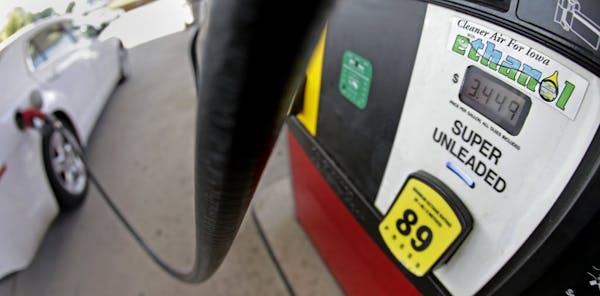WASHINGTON – An Obama administration plan to lower the target for biofuels in the nation's gasoline supply is causing a rift with leading Minnesota lawmakers over a vital state industry that recently opened its first gas station offering a 15 percent ethanol blend.
The proposal comes as corn-based ethanol, once seen as a green alternative to imported oil, is increasingly under attack by a host of detractors, from oil companies to environmentalists worried about land conservation.
"It's a huge threat," said Jerry Demmer, a Clarks Grove, Minn., corn grower and chairman of the Minnesota Corn Research and Promotion Council. "They smell blood in the water."
Farmers in Minnesota, which ranks fifth nationally in ethanol production, are casting the proposal as a win for Big Oil, which considers the ethanol standard an unwanted intrusion in the gasoline market.
Their Minnesota backers in Congress agree.
"At a time when the oil industry continues to receive billions of dollars in unnecessary subsidies, this decision is wrong," said Sen. Amy Klobuchar.
Sen. Al Franken, a fellow Democrat, cited "homegrown jobs" from renewable energy. "This is not the time to send a signal that we're cutting back on biofuels," he said.
The Obama administration says that it remains committed to biofuels, but that it is proposing for the first time to dial back refinery targets set in a landmark 2007 law that mandated a steady rise in the amount of ethanol blended into gasoline.
The new targets, known as the Renewable Fuel Standard, have set up a high-test lobbying battle between Midwestern farmers and an array of competing interests who have long complained that the national ethanol mandate distorts the economics of the food, automotive and oil industries. Some have called for repeal of the mandate altogether.
The Environmental Protection Agency, which announced the plan last week, points to modern improvements in automotive fuel efficiency and technical constraints, or a "blend wall," on how much ethanol the market can absorb.
Given Obama's background as a senator from the Corn Belt state of Illinois, and the ethanol industry's deep bipartisan support in the Midwest, some analysts view the change as a breakthrough.
"For the first time, EPA has acknowledged that the blend wall is a dangerous reality and that breaching it would have serious impacts on America's fuel supply and would be harmful for American consumers," said Jack Gerard, CEO of the American Petroleum Institute, which represents the oil and natural gas industry.
Producers of chickens, turkeys and other livestock — complaining of higher corn prices — also have welcomed the EPA plan, which would drop the nation's corn ethanol blending target in 2014 from 14.4 billion to 13 billion gallons.
'You can keep it'
Currently, about a quarter of the nation's corn production is devoted to ethanol, according to the Department of Agriculture.
The overall biofuels target — including biodiesel — would be set at 15.2 billion gallons next year, down from 16.5 billion this year. That prompted Rob Green of the National Council of Chain Restaurants to observe tartly: "If you like your 15 billion gallon corn ethanol mandate, you can keep it."
The revised targets appear sufficient to meet the 10 percent ethanol blend that is standard at most of the nation's 160,000 gas stations, meaning that motorists are unlikely to notice the difference.
But ethanol boosters say the cut could hamper investment in the next generation of cellulosic ethanol made from wood, grasses and other plant matter. They also note that despite objections from automakers, the EPA has approved the use of E15 — the 15 percent blend now being introduced in Minnesota and a handful of other states — for cars built after 2001.
U.S. Reps. Tim Walz and Collin Peterson, both Democrats from rural Minnesota districts, have panned the lower targets. Peterson, the ranking Democrat on the House Agriculture Committee, called the EPA move "very disappointing." Walz, a negotiator on the farm bill, said it would "weaken an emerging industry."
The three Minnesota Republicans in the U.S. House have remained silent on the rule so far. None responded last week to requests for comment.
But the proposal has bipartisan support elsewhere in Congress. Michigan Republican Fred Upton, chairman of the House Energy and Commerce Committee, said the proposed rule "would alleviate immediate pressure on the looming blend wall."
The committee's ranking Democrat, Henry Waxman of California, said the Obama plan "thoughtfully addresses" the challenge of integrating increasing levels of ethanol into a shrinking gasoline pool.
And U.S. Agriculture Secretary Tom Vilsack, the former governor of corn-rich Iowa, cast the proposal as part of a "long-term approach" to managing the growth of ethanol in fuel.
'Always on the defense'
Barring any legal action, the new EPA standards could be made final in the spring, after a 60-day public comment period.
Minnesota corn growers still hope to jettison the plan, arguing that it could threaten the future of the state's 21 ethanol plants, including two that are closed but that are expected to reopen. While some environmentalists have grown ambivalent about the ecological benefits of ethanol production, which consumes land and energy, the industry has found some new allies on the left.
Brad Woodhouse, president of Americans United for Change, a pro-Obama group, came out strongly this week against the change, saying "we need to make sure we offset the money of Big Oil."
The group vowed to mount a grass-roots effort along with VoteVets.org to equate support for biofuels with support for the troops, since it's an alternative to imported oil.
For Demmer, who farms about 900 acres of corn and soybeans in southern Minnesota, the debate is about his livelihood, which depends on healthy markets for both food and biofuels. The industry always has had its skeptics, he said, but now it's embattled like never before.
"It seems like we're always on the defense," he said. "But we do have a good story to tell."
Follow Kevin Diaz on Twitter: @StribDiaz
Former DFL Senate Majority Leader Kari Dziedzic dies of cancer at age 62

How the Star Tribune is covering the 2024 election

Fact check: Walz and Vance made questionable claims during only VP debate

In Tim Walz's home city, opposing groups watch him debate on the national stage

